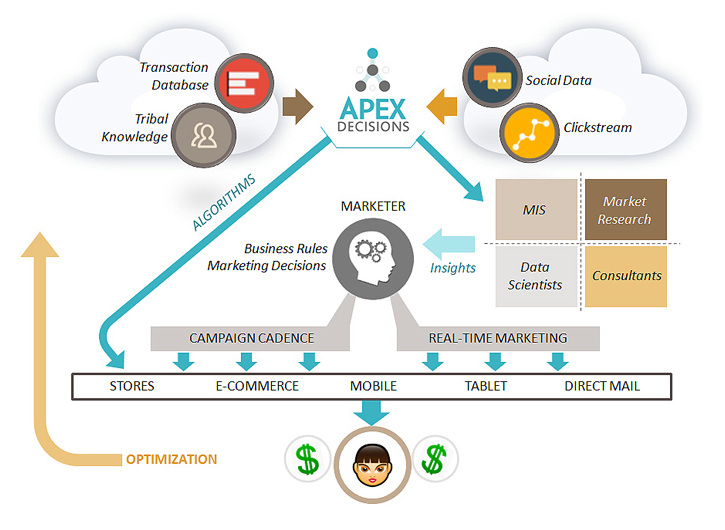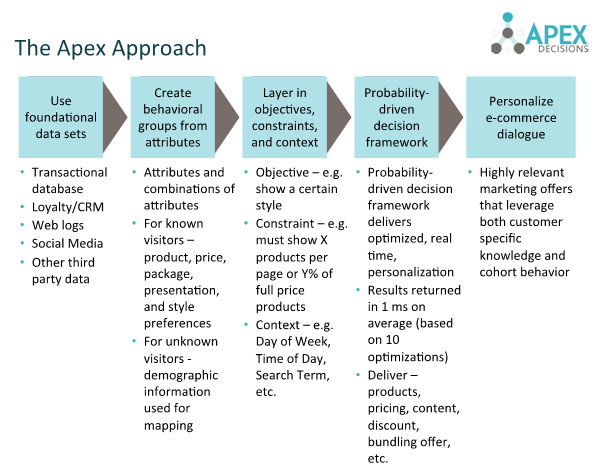How It Works

Price optimization models
In Apex’s world, pricing optimization is a science. Apex approaches pricing optimization as selling a package of features and services that a consumer finds valuable, with each feature adding or subtracting to value. The pricing is also impacted by the knowledge a consumer has of the business’s pricing, negotiating/discounting promotions strategy. Consumers who were able to get a better price in the past; compare the renewal price offer and implied increment with the knowledge that a better price might be achieved by letting the subscription expire. The amount of discounts and deals that were offered by the business in the past become benchmarks in the evaluation of the current offer.
The combination of price sensitivity, perceived value of the product and the consumer’s knowledge of businesses’ marketing and pricing strategy requires pricing at an individual level to maximize business objectives.
Our current subscription pricing pilot for a media company improved revenues by approximately 20%.
Approach
Price optimization is based on the following principles:
The Price Sensitivity of an Individual
The key requirement for our pricing model is to understand consumer’s price sensitivity. In other words: how much do they care about price? How much effort will they invest in educating themselves about alternatives? The purchase takes place in a broader framework of deriving value for a consumer. For media product consumption, a consumer finds value not only in the content but also in the timeliness of delivery, channel of delivery and relevance to the consumer.
Apex is able to derive a consumer’s price sensitivity by analyzing their history of transactions and the prices the consumer paid for the type of articles consumed and the context of consumption.
The price a business can charge depends also on the knowledge a consumer has of the ability to negotiate and the kind of price reductions possible with negotiations.
Negotiations and Discounting
Every time a business offers discounts by means of coupons, markdowns and other offers or explicit negotiations trains a consumer in a business’s pricing and discounting strategy. So the consumer based on how price sensitive they are will use the knowledge every time they buy products or services from the business.
The Value of the Product/Service
The amount a consumer is willing to pay for the product and service bundle depends on how much value they derive from it. We focus on understanding the different features of the product/service bundle. Then, based on a consumer’s needs, we combine different features to create packages that appeal to each user’s unique needs. This also allows individuals to feel like they are being treated fairly, when we try to price each consumer differentially. For example, as a media company, we could create packages where individuals get their magazine as well as notifications about specific topics they are interested in via text or email, on a weekly or daily basis or urgent basis—all, of course, depending on their preference. A good negotiating strategy emphasizes the features users care about the most, while trying to win back a consumer after refusing to auto renew.
Apex derives consumer value by predicting the overall likelihood the consumer will continue to renew, based on transaction history, consumption history, negotiating history and overall context such as feedback and service reviews.
Price vs. Probability of renewal
Apex segments the users based on the price elasticity at this stage. For the product with large amounts of data we get as many as twelve distinct price elasticity groups. For each segment we also obtain the change in conversion rate as renewal prices are changed.
Business Objectives, Constraints, and Context
Pricing must account for the short, medium and long term objectives, like market share, profitability, revenue or profit and impact on share price. Or be totally focused on optimizing the life time value of a consumer. Life time value of a consumer is really complex and is impacted by the business’s flexibility in creating packages that they really love, pricing the services that the consumer finds fair and delivering a consumption experience which delights them and is consistent and improving over time.
In Apex’s approach once we have the probability of a buyer buying a product as a function of price, we then need to select an optimal price based on the company’s objectives. Optimization models can be built and configured based on the objective chosen by the business:
Revenue
It is trivial, revenue = price * probability of buying, unless we have fixed inventory in the short term like Airlines, hotels and car rentals where we need to model the opportunity cost of the product we are selling to put a cutoff on the minimum price offered. The opportunity cost or the marginal value of inventory is how much extra money the company would make if they had not sold this inventory.
Profit
In these cases we need to understand the marginal cost of the package. Then the optimization is trivial as profit = (price – marginal cost)* probability.
A more sophisticated model would be profitability = (price – marginal cost – opportunity cost) * probability.
Market share
These models require macro level modelling to understand the tradeoff of price discrimination with capturing the demand.
Lifetime value maximization
Apex’s approach for life time value requires creation of another model which predicts the life time value. The lifetime value is significantly impacted by a variety of factors – i.e. the price/discount offers made from transaction to transaction, the quality of the product or service and the experience of recovery from service failures.
The most important factor to be understood for a media company is the perception of fairness of pricing and delivery of offers. With differential pricing as soon as the price goes beyond what is perceived as fair by the consumer, and the business tries to win back the consumer by offering discounts, it triggers a variety of changes in a consumer perception of fairness and hence the life time value.
Life time value models need to be uniquely created for each media company taking into account all the touch points with consumers, including value delivery, service failure recovery, or just simple informational query handling.

